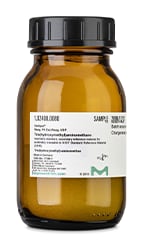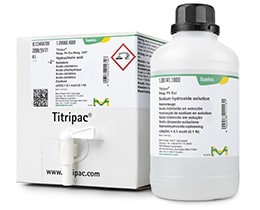Importance of Volumetric Solution Standardization
Bettina Straub-Jubb, Merck
The so-called titer determination or standardization of a volumetric solution used for titration is one of the most important preconditions for reliable and transparent titration results. Accurate and reliable titration results are only achievable when we work with the exact concentration of the volumetric solution.
The nominal concentration of a volumetric solution used as a titrant in the titration process is known. The concentration could differ from the real concentration because of a variety of influences. The necessity to determine the real concentration with a titrimetric standard is import in order to obtain correct titration results.
The Titration Process

1. Sample Preparation
Preparing or dissolving the sample to have free ions for the stoichometric reaction before the titration.
2. Titer Determination
So-called standardization of the titration system to correct measurement uncertainties through the instrument, the volumetric solution, the handling, the temperature in the lab, and the balance.
3. Sample Titration
The last step in the titration process is the titration of the dissolved sample with a volumetric solution of an exact known concentration.
The Titer Determination
The titer is defined as the quotient of the nominal concentration of a volumetric solution and the actual concentration. The calculated factor is then used as the correction factor to the titrant. The measured value of the titer is multiplied with the nominal concentration.
Titer = c (x) / c~ (X)
c = c~(x) × titer
Titer = factor
c = actual molar concentration of the volumetric solution
c~ = nominal molar concentration of the volumetric solution
The Titration Process Is Influenced by the Following Factors:
- Measuring method
- Instrument (instrument uncertainty/abrasion of the burette)
- Electrodes (electrode uncertainty/alteration of electrodes)
- Handling
- Balance (weighing error)
- Temperature
- Volumetric solution (change of the concentration,through alteration, carbon dioxide, vaporation of water/solvent)
All the mentioned points could be eliminated with the determination of the titer as a correction factor.
It is important to exactly define both the sample method and the titer method to receive correct titration and titer results. The instrument itself could differ slightly, as well as the burette, which would change the volume, especially with alkaline solutions; therefore, a titer determination must be done with the same instrument used for the sample determination. Depending on usage and treatment of the electrodes, their lifetime and accuracy can vary. Refined distinction in the handling could also influence the results. Another important variation is the volume change of a volumetric solution at different temperatures. The temperature influence for an aqueous solution is 0.02% per degree and 0.1% per degree for organic solutions. Working in an air-conditioned lab is preferred. Also, the accuracy of the balance and the weighing process is important. The weighed portion of a substance must be great enough for a correct titer result. Ideally, if the concentration of the volumetric solution is quite low, one can also prepare a solution of the volumetric standard and weigh in a higher amount of the standard, which reduces the weighing error.
The stability of the titrants themselves are different and depend on the storage conditions. In general, it can be stated that alkaline solutions and Titriplex® solutions are less stable than acid solutions. Alkaline solutions, for example, absorb carbon dioxide from the environment and their concentration can change rapidly. Iodine solutions and potassium permanganate solutions are light sensitive. A di-Ammonium iron(II)-sulfate solution is a quite unstable volumetric solution and needs a more frequent concentration determination. These are only a few examples.
To compensate for all of these influences in your titration process, a regular titer determination is recommended. The frequency is dependent on the kind of solutions and the conditions in the laboratory. Using Titripac® packaging, the solution itself is stable and not influenced by alteration, carbon dioxide, evaporation of water or solvent, or microbes. With Titripac®, the frequency of a titer determination could be reduced. It is recommend to do always a titer determination after opening a new bottle or Titripac®. Depending on the stability of the solutions and the conditions in the lab, the time between further titer determinations can be defined individually by the user. The Certipur® volumetric standards are high purity solid substances determined with exact assays and are directly traceable to NIST (National Institute of Standards and Technology Gaithersburg, USA) volumetric standards. They are recommended for an exact titer determination. It is important to dry them before use.

Certipur® volumetric standard

Titripur® volumetric solution
Conclusion
The base for every accurate and reliable titration method are high quality volumetric solutions and accurate high purity standards for a correct and reliable titer determination.
The Titripur® volumetric solutions portfolio is comprised of high quality solutions for a wide range of applications, and in combination with the high-purity Certipur® volumetric standards and the individual support from our experts, titration processes are made accurate and reliable.
如要继续阅读,请登录或创建帐户。
暂无帐户?